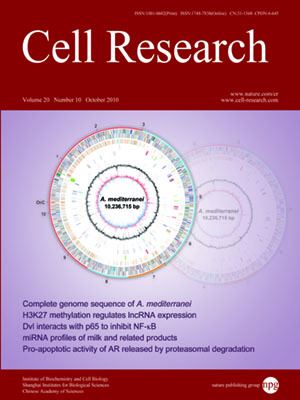
Volume 20, No 10, Oct 2010
ISSN: 1001-0602
EISSN: 1748-7838 2018
impact factor 17.848*
(Clarivate Analytics, 2019)
Volume 20 Issue 10, October 2010: 1109-1116
ORIGINAL ARTICLES
Role of H3K27 methylation in the regulation of lncRNA expression
Susan C Wu1,2, Eric M Kallin1,2,3 and Yi Zhang1,2
1Howard Hughes Medical Institute, University of North Carolina at Chapel Hill, Chapel Hill, NC 27599-7295, USA
2Department of Biochemistry and Biophysics, Lineberger Comprehensive Cancer Center, University of North Carolina at Chapel Hill, Chapel Hill, NC 27599-7295, USA
3Current address: Center for Genomic Regulation, 08003 Barcelona, Spain
Correspondence: Yi Zhang,(yi_zhang@med.unc.edu)
Once thought to be transcriptional noise, large non-coding RNAs (lncRNAs) have recently been demonstrated to be functional molecules. The cell-type-specific expression patterns of lncRNAs suggest that their transcription may be regulated epigenetically. Using a custom-designed microarray, here we examine the expression profile of lncRNAs in embryonic stem (ES) cells, lineage-restricted neuronal progenitor cells, and terminally differentiated fibroblasts. In addition, we also analyze the relationship between their expression and their promoter H3K4 and H3K27 methylation patterns. We find that numerous lncRNAs in these cell types undergo changes in the levels of expression and promoter H3K4me3 and H3K27me3. Interestingly, lncRNAs that are expressed at lower levels in ES cells exhibit higher levels of H3K27me3 at their promoters. Consistent with this result, knockdown of the H3K27me3 methyltransferase Ezh2 results in derepression of these lncRNAs in ES cells. Thus, our results establish a role for Ezh2-mediated H3K27 methylation in lncRNA silencing in ES cells and reveal that lncRNAs are subject to epigenetic regulation in a similar manner to that of the protein-coding genes.
Cell Research (2010) 20:1109-1116. doi:10.1038/cr.2010.114; published online 3 August 2010
FULL TEXT | PDF
Browse 2368


